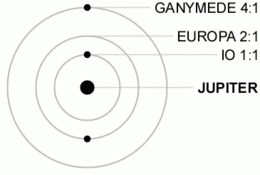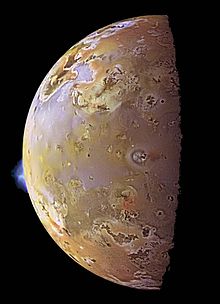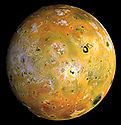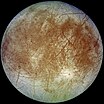Astronomy college course/Galilean moons of Jupiter
From https://en.wikipedia.org/w/index.php?title=Galilean_moons&oldid=596335458Log out
Discovery[edit | edit source]

The Galilean moons are the four moons of Jupiter discovered by Galileo Galilei. They are the largest of the 67 moons of Jupiter and among the more massive moons in the Solar System. They were discovered soon after Galileo made improvements to his telescope around January 1610. The incontrovertible discovery of celestial bodies orbiting something other than the Earth dealt a serious blow to the then-accepted Ptolemaic world system (in which everything orbits around the Earth).
After Newton published his three laws of motion in 1687, it became possible to measure the mass of Jupiter using the orbital periods of the moons. (The fact that each moon gave the same estimate further confirmed the power of Newtonian mechanics.) But since certain important facts were not yet known, it was only possible to measure the mass of Jupiter relative to the mass of the Sun. In other words, Jupiter was established to have a mass equal to approximately 0.001 (a thousand times less) than the mass of the Sun. But the mass of the Sun, Jupiter, or even the Earth could only be crudely estimated at the time.
Orbital resonances[edit | edit source]

The three inner moons – Ganymede, Europa, and Io – participate in a 1:2:4 orbital resonance. In other words, Europa's orbital period (around Jupiter) is 2 times as long as Io's orbit, and the ratio of Ganymede's orbit to that of Europa is also 2 (which is equal to 4/2). Orbiting objects tend to settle into such resonances when they are massive enough to influence each other's orbit via their gravitational interactions.
Table of properties (show/hide)[edit | edit source]

There are a number of explainable patterns among the moons, all related to the fact that the inner moons (starting with Io) experiences the greater tidal distortions which leads to the most heat being delivered to the core. Io is anhydrous and likely has an interior of rock and metal. Europa is thought to contain 8% ice and water by mass with the remainder rock.[1] These moons are, in increasing order of distance from Jupiter:
Geological features[edit | edit source]

- :"I Eat Green Carrots" is a useful mnemonic for remembering the names in increasing order of distance from Jupiter.
The geological differences between the Moons can be explained by the sequence of less tidal heating of the cores as one moves away from the central body, Jupiter. As one moves in this progression:
- The density decreases as the lighter and more volatile elements tend to evaporate.
- The geological activity decreases, since heating a planet (or any fluid) below tends to make the the fluid convection.
- The number of impact craters increases because the surfaces are older.
Io[edit | edit source]

See:Io
Io is the innermost of the four Galilean moons of Jupiter and, with a diameter of 3,642 kilometers, the fourth-largest moon in the Solar System. With over 400 active volcanoes, Io is the most geologically active object in the Solar System.< Its surface is dotted with more than 100 mountains, some of which are taller than Earth's Mount Everest. Unlike most satellites in the outer Solar System (which have a thick coating of ice), Io is primarily composed of silicate rock surrounding a molten iron or iron sulfide core.
Although not proven, recent data from the Galileo orbiter indicate that Io might have its own magnetic field. Io has an extremely thin atmosphere made up mostly of sulfur dioxide (SO2). If a surface data or collection vessel were to land on Io in the future, it would have to be extremely tough (similar to the tank-like bodies of the Soviet Venera landers) to survive the radiation and magnetic fields that originate from Jupiter.
Europa[edit | edit source]
See: Europa
Europa, the second of the four Galilean moons, is the second closest to Jupiter and the smallest at 3121.6 kilometers in diameter, which is slightly smaller than Earth's Moon.
It is one of the smoothest objects in the solar system, with a layer of water surrounding the mantle of the planet, thought to be 100 kilometers thick. The smooth surface includes a layer of ice, while the bottom of the ice is theorized to be liquid water. The apparent youth and smoothness of the surface have led to the hypothesis that a water ocean exists beneath it, which could conceivably serve as an abode for extraterrestrial life. Heat energy from tidal flexing ensures that the ocean remains liquid and drives geological activity. Life may exist in Europa's under-ice ocean, perhaps subsisting in an environment similar to Earth's deep-ocean hydrothermal vents or the Antarctic Lake Vostok. Life in such an ocean could possibly be similar to microbial life on Earth in the deep ocean. So far, there is no evidence that life exists on Europa, but the likely presence of liquid water has spurred calls to send a probe there.
The prominent markings that criss-cross the moon seem to be mainly albedo features, which emphasize low topography. (In other words, they are not believed to be prominent ridges or valleys, but primarily differences in color and how much light is reflected.) There are few craters on Europa because its surface is tectonically active and young. Some theories suggest that Jupiter’s gravity is causing these markings, as one side of Europa is constantly facing Jupiter. Also, volcanic water eruptions splitting the surface of Europa, and even geysers have been considered as a cause. The color of the markings, reddish-brown, is theorized to be caused by sulfur, but scientists cannot confirm that, because no data collection devices have been sent to Europa. Europa is primarily made of silicate rock and likely has an iron core. It has a tenuous atmosphere composed primarily of oxygen.
Ganymede[edit | edit source]
See: Ganymede
Ganymede, the third Galilean moon is the largest natural satellite in the Solar System at 5262.4 kilometers in diameter, which makes it larger than the planet Mercury - although only at about half of its mass, since Ganymede is an icy world. It is the only satellite in the Solar System known to possess a magnetosphere, likely created through convection within the liquid iron core.
Ganymede is composed primarily of silicate rock and water ice, and a salt-water ocean is believed to exist nearly 200 km below Ganymede's surface, sandwiched between layers of ice. The metallic core of Ganymede suggests a greater heat at some time in its past than had previously been proposed. The surface is a mix of two types of terrain – highly cratered dark regions and younger, but still ancient, regions with a large array of grooves and ridges. Ganymede has a high number of craters, but many are gone or barely visible due to its icy crust forming over them. The satellite has a thin oxygen atmosphere that includes O, O2, and possibly O3 (ozone), and some atomic hydrogen.
| This page has been nominated for cleanup for the following reason: the rest of this article was copied from Wikipedia and needs a bit more editing. Please edit this page to improve it. See this module's talk page for discussion. |
Callisto[edit | edit source]
Callisto is the fourth and last Galilean moon, and is the second largest of the four, and at 4820.6 kilometers in diameter, it is the third largest moon in the Solar System. Callisto was a daughter of the Arkadian King Lykaon and a hunting companion of the goddess Artemis. It does not form part of the orbital resonance that affects three inner Galilean satellites and thus does not experience appreciable tidal heating.[4] Callisto is composed of approximately equal amounts of rock and ices, which makes it the least dense of the Galilean moons. It is one of the most heavily cratered satellites in the solar system, and one major feature is a basin around 3000 km wide called Valhalla.
Callisto is surrounded by an extremely thin atmosphere composed of carbon dioxide[5] and probably molecular oxygen.[6] Investigation revealed that Callisto may possibly have a subsurface ocean of liquid water at depths greater than 100 kilometers.[7] The likely presence of an ocean within Callisto indicates that it can or could harbor life. However, this is less likely than on nearby Europa.[8] Callisto has long been considered the most suitable place for a human base for future exploration of the Jupiter system since it is furthest from the intense radiation of Jupiter.[9]
Comparative structure[edit | edit source]
Fluctuations in the orbits of the moons indicate that their mean density decreases with distance from Jupiter. Callisto, the outermost and least dense of the four, has a density intermediate between ice and rock whereas Io, the innermost and densest moon, has a density intermediate between rock and iron. Callisto has an ancient, heavily-cratered and unaltered ice surface and the way it rotates indicates that its density is equally distributed, suggesting that it has no rocky or metallic core but consists of a homogenous mix of rock and ice. This may well have been the original structure of all the moons. The rotation of the three inner moons, in contrast, indicates differentiation of their interiors with denser matter at the core and lighter matter above. They also reveal significant alteration of the surface. Ganymede reveals past tectonic movement of the ice surface which required partial melting of subsurface layers. Europa reveals more dynamic and recent movement of this nature, suggesting a thinner ice crust. Finally, Io, the innermost moon, has a sulphur surface, active volcanism and no sign of ice. All this evidence suggests that the nearer a moon is to Jupiter the hotter its interior. The current model is that the moons experience tidal heating as a result of the gravitational field of Jupiter in inverse proportion to the square of their distance from the giant planet. In all but Callisto this will have melted the interior ice, allowing rock and iron to sink to the interior and water to cover the surface. In Ganymede a thick and solid ice crust then formed. In warmer Europa a thinner more easily broken crust formed. In Io the heating is so extreme that all the rock has melted and water has long ago boiled out into space.
Size[edit | edit source]

Visibility[edit | edit source]

All four Galilean moons are bright enough that they could, if they were farther away from Jupiter, be sighted from Earth without a telescope. (They are, however, easily visible with even low-powered binoculars.) They have apparent magnitudes between 4.6 and 5.6 when Jupiter is in opposition with the Sun,[11] and are about one unit of magnitude dimmer when Jupiter is in conjunction. The main difficulty in observing the moons from Earth is their proximity to Jupiter since they are obscured by its brightness.[12] The maximum angular separations of the moons are between 2 and 10 minutes of arc from Jupiter,[13] close to the limit of human visual acuity. Ganymede and Callisto, at their maximum separation, are the likeliest targets for potential naked-eye observation. The easiest way to observe them is to "cover" Jupiter with an object, e.g., a tree limb or a utility pole that is perpendicular to the plane of the moons' orbits.
See also[edit | edit source]
External links[edit | edit source]
- Animation of Galileo's observation, march 1613
- Sky & Telescope utility for identifying Galilean moons
- ↑ Cite error: Invalid
<ref>tag; no text was provided for refs namedarxiv0812 - ↑ Computed using the IAU-MPC Satellites Ephemeris Service µ value
- ↑ Source: JPL/NASA
- ↑ Musotto, Susanna; Varadi, Ferenc; Moore, William; Schubert, Gerald (2002). "Numerical Simulations of the Orbits of the Galilean Satellites". Icarus 159 (2): 500–504. doi:10.1006/icar.2002.6939.
- ↑ Carlson, R. W. et al. (1999). "A Tenuous Carbon Dioxide Atmosphere on Jupiter's Moon Callisto" (PDF). Science 283 (5403): 820–821. doi:10.1126/science.283.5403.820. PMID 9933159. http://trs-new.jpl.nasa.gov/dspace/bitstream/2014/16785/1/99-0186.pdf.
- ↑ Liang, M. C.; Lane, B. F.; Pappalardo, R. T. et al. (2005). "Atmosphere of Callisto" (PDF). Journal of Geophysics Research 110 (E2): E02003. doi:10.1029/2004JE002322. http://yly-mac.gps.caltech.edu/ReprintsYLY/N164Liang_Callisto%2005/Liang_callisto_05.pdf.
- ↑ Showman, Adam P.; Malhotra, Renu (1999). "The Galilean Satellites" (PDF). Science 286 (5437): 77–84. doi:10.1126/science.286.5437.77. PMID 10506564. http://www.lpl.arizona.edu/~showman/publications/showman-malhotra-1999.pdf.
- ↑ Lipps, Jere H.; Delory, Gregory; Pitman, Joe et al. (2004). Hoover, Richard B; Levin, Gilbert V; Rozanov, Alexei Y. eds. "Astrobiology of Jupiter's Icy Moons" (PDF). Proc. SPIE. Instruments, Methods, and Missions for Astrobiology VIII 5555: 10. doi:10.1117/12.560356. http://learning.berkeley.edu/astrobiology/2004ppt/jupiter.pdf.
- ↑ Trautman, Pat; Bethke, Kristen (2003). "Revolutionary Concepts for Human Outer Planet Exploration(HOPE)" (PDF). NASA.
- ↑ 10.0 10.1 10.2 10.3 Ringwald, Frederick A. (29 February 2000). "SPS 1020 (Introduction to Space Sciences)". California State University, Fresno. Retrieved 5 January 2014.
- ↑ Yeomans, Donald K. (2006-07-13). "Planetary Satellite Physical Parameters". JPL Solar System Dynamics. Retrieved 2008-08-23.
- ↑ Jupiter is about 750 times brighter than Ganymede and about 2000 times brighter than Callisto.
Ganymede: (5th root of 100)^(4.4 Ganymede APmag - (-2.8 Jup APmag)) = 758
Callisto: (5th root of 100)^(5.5 Callisto APmag - (-2.8 Jup APmag)) = 2089 - ↑ Jupiter near perihelion 2010-Sep-19: 656.7 (Callisto angular separation arcsec) - 24.9 (jup angular radius arcsec) = 631 arcsec = 10 arcmin









